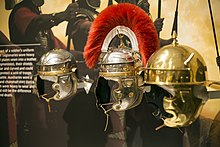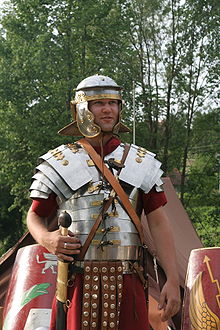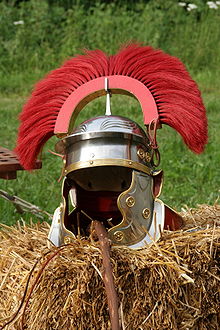
Back غاليا (خوذة) Arabic Galea Catalan Galea (přilba) Czech Galea (Helm) German Gálea Spanish Casque romain French Gálea GL Գալեա (սաղավարտ) HY Elmo (esercito romano) Italian ガレア Japanese




A galea ([ˈɡaɫea], from Greek γαλέη, galéē, "weasel, marten")[1] was a Roman soldier's metal helmet, most famously worn by the heavy infantry of the legions. Some gladiators, specifically murmillo (myrmillo), also wore bronze galeae with face masks and decorations, often a fish on its crest.[2] While details varied over time, all Roman galeas from the Republic era through the Principate featured the same basic design - a bowl to protect the skull, a neck guard (which grew larger over time), a deflector band to protect the forehead and cheek plates to protect the face. The exact form, type of metal, and design of the helmet varied over time, between differing unit types, and also between individual examples – pre-industrial production was by hand – so it is not certain to what degree there was any standardization even under the Roman Empire.
Originally, Roman helmets were influenced by the neighboring Etruscans, people who utilised the "Nasua" type helmets. The Greeks in the south also influenced Roman design in its early history.
The primary evidence is scattered archaeological finds, which are often damaged or incomplete; secondary evidence includes period depictions of galeae, generally in bas-relief sculpture and mosaic.